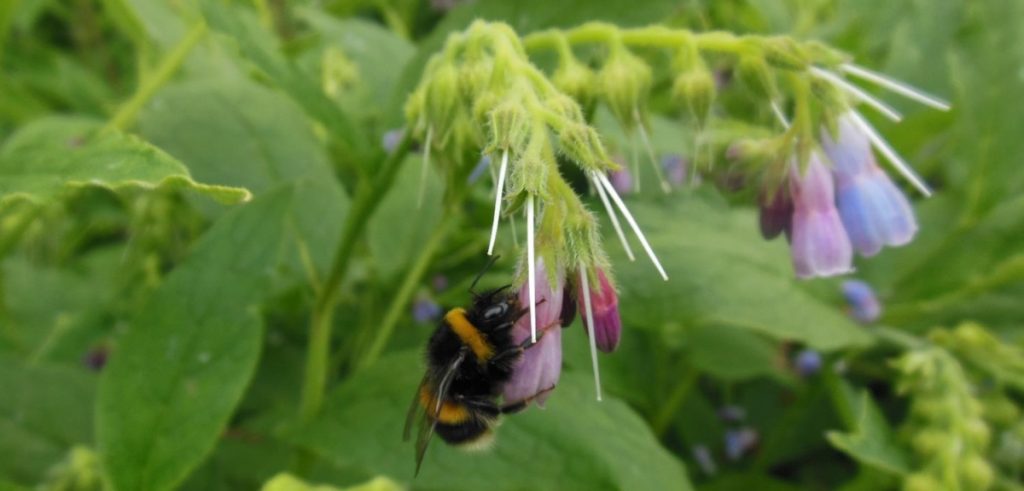The relationship between bees and flowers is one of the best examples for mutualism: the flowers get pollinated and the bees get food. Perfect, isn’t it? It is. But, sometimes bees don’t give the return service. They take the nectar without pollinating. That’s what’s called nectar robbing. It sounds quite deceiptful and not in line with the image we usually have from bees. Putting moral objections aside, this is a quite interesting behaviour. It happens when a short-tongued bee – let’s say a buff-tailed bumblebee (Bombus terrestris) – wants to get the nectar from a flower with a long corolla – let’s say a comfrey flower. This tongue is too short, but she has strong mandibles. Therefore, she might bite a hole in this flower so that even a short tongue can reach the nectaries.

Comfrey flowers are too long for short-tongued bumblebees. They help themselves by biting holes in the base of the flower, near where the nectaries are.
Nectar robbing seems to be quite common, birds, insects and sometimes also mammals do it. I recommend this excellent review by Rebecca Irwin and colleagues. Between insects, bees are the most common nectar robbers. My image of a typical bee doing it is B. terrestris, as in the image above this post. Always when I see comfrey, delphinium, columbine or a similar flower somewhat more “reserved” than a raspberry flower I check it for holes. One of the weird activities that make people stare at me. Comfrey very often has them, they must have lots of delicious nectar that make short-tongued bees fancy it. It is usually visited by long-tongues bees, like garden bumblebees.

The legitimate way of visiting comfrey. Garden bumblebees have very long tongues and also narrow heads. Ideal pollinators for “reserved” flowers.
Nectar robbing from a bee’s perspective…
After the primary robber has made the hole, also other bees visit it to get their piece of the cake. I have mostly seen honey bees doing that, but the other day I saw something that really amazed me. I have a delphinium on my terrace, which is a typical flower for being robbed. It still has no holes, but there was a early bumblebee flying around the base of the still closed flowers. Cheeky little thing! This species isn’t a primary robber, but apparently she knew that there may be an easy way to get some nectar. Never seen that before. I will continue checking this plant. Buff-tailed bumblebees are quite common on my terrace.

Buff-tailed bumble legitemately visiting knapweed. It’s the type of flower they usually feed on.
Though it is common, nectar robbing intrigues me. Apparently the bees’ behaviour shifts to robbing more easily if there is competition for nectar. But for this mentioned early bumble there would have been plenty of open flowers both on my terrace and the neighbour’s garden. Why checking a closed bud for holes? Is it better to be the very first to sip on a flower’s nectar? Is delphinium or comfrey nectar special – by caloric content or secondary metabolites that may help against parasites? There are still many open questions, and many of them refer to the bees’ perspective, as Irwin and her coauthors point out:
- Is there a fitness benefit of nectar robbing?
- Why do some pollinators switch between legitemately feeding and nectar robbing and others don’t?
- Is there a trade-off for “honest” versus robbing behaviour?
- Do social bees steal more frequently than solitary bees?
- Is robbing learned or innate?
The last question intrigues me most, after seeing this early bumblebee on my terrace…
… and from the plant’s view
At first sight the bees get all the benefits and the flowers the harm. But it’s not as easy as this. Of course, flowers produce nectar not for the robbers but for the pollinators. Their reproductive organs may be damaged, they have higher costs in compensating that nectar loss and diseases may come in. But plants are also able to defend themselves. They may thicken their calyces (that’s the green “cup” holding the base of the flower), so that it’s harder for the bees to make a hole. Or they may use chemicals to deter nectar robbing. The tissue of tobacco flowers, for instance, has more nicotine in the region where the nectaries are. Fascinating… Flowers may have these chemicals already “build in” or produce them only after being hurt.
But of course, things get even more complicated. These chemicals may deter also those pollinators which wanted to go the “right” way by the flower entrance. It may be costly for the plant to produce them. And – I like this one – bees may use these chemicals to medicate themselves. So, is this chemical defence effective?
So, there is still much to know and research, I obviously just scratched on the surface of the phenomenon. I think I will burry myself a bit in the library to see what else I can find. Unless it’s sunny and I can observe nectar robbing bumblebees on my terrace or on some nice wild flower meadow.




I saw this and thought it was an invasive species.
Hi Sharon, yes, that may be an assumption to make if you never heard of nectar robbing – we have this picture in our heads of bees as being pure altruistic little helpers. The thing is: Bees or other pollinators don’t care about our morals. They’re looking for food and if there’s an easier way to get it, they will do. As it often occurs, it’s a matter of balance. If all bees did just that, the system wouldn’t work. If a proportion of them does it, it “works”. It’s not a matter of invasive or native species, but of availability of resources. There’s much more to this, but it’s difficult to make an evolutionary ecology lesson in this context…